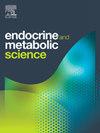Metabolomics identify serum biomarkers for predicting acute exacerbation and severity of bronchiectasis
Q3 Medicine
引用次数: 0
Abstract
Background
Bronchiectasis (BE) is a chronic respiratory disease. Acute BE exacerbation caused by recurrent infections can lead to hemoptysis and even asphyxia, with high mortality and long hospitalization. This study aimed to identify novel diagnostic metabolic biomarkers for predicting acute exacerbation and severity of BE.
Methods
A liquid chromatography–mass spectrometry (LC–MS)-based untargeted metabolomic analysis was performed for serum samples from 45 patients with acute BE exacerbation and 15 healthy controls. The diagnostic value of the candidate metabolites was evaluated using receiver operating characteristic (ROC) curves.
Results
Based on bronchiectasis severity index (BSI) scores, patients with acute BE exacerbation were classified into mild, moderate, and severe BE groups. Compared to healthy controls, the abundance of 4-acetamidobutyric acid was elevated in the mild, moderate, and severe groups (p < 0.05), with no significant difference among the three groups. In the severe BE group, the abundances of taurochenodecoxycholic acid, oleamide, hexadecanamide, and glycodeoxycholic acid were significantly elevated from those in mild and moderate BE groups (p < 0.05), with Youden index (YI) ≥ 0.8 for all metabolites; the combination of these 4 metabolites had an area under the ROC curve (AUROC) of 0.99, a sensitivity of 100 % and a specificity of 93.3 % for identifying severe BE. Pathway analysis reveals that abnormally enriched metabolites in BE patients are associated with PI3K-Akt signaling pathway, mTOR signaling pathway, FoxO signaling pathway, renin-angiotensin system signaling pathway, asthma signaling pathway, and FcεRI signaling pathway, where prostaglandin D2 exerts direct or indirect impacts on these pathways.
Conclusion
4-Acetamidobutyric acid can serve as a biomarker for predicting acute BE exacerbation, while taurochenodecoxycholic acid, oleamide, hexadecanamide, and glycodeoxycholic acid are robust biomarkers for predicting severe BE. Prostaglandin D2 plays a crucial role in promoting the pathogenesis of pulmonary inflammatory cell recruitment, cell autophagy, and pulmonary fibrosis during acute BE exacerbation. Overall, this study identifies biomarkers for predicting acute BE exacerbation and provides new targets for drug development.
代谢组学鉴定预测支气管扩张急性加重和严重程度的血清生物标志物
背景支气管扩张症(BE)是一种慢性呼吸道疾病。反复感染引起的急性BE加重可导致咯血甚至窒息,死亡率高,住院时间长。本研究旨在确定新的诊断代谢生物标志物,以预测BE的急性加重和严重程度。方法采用液相色谱-质谱法(LC-MS)对45例急性BE加重患者和15例健康对照者的血清进行非靶向代谢组学分析。使用受试者工作特征(ROC)曲线评估候选代谢物的诊断价值。结果根据支气管扩张严重程度指数(BSI)评分,将急性BE加重患者分为轻度、中度和重度BE加重组。与健康对照组相比,轻度、中度和重度组的4-乙酰氨基丁酸丰度升高(p <;0.05),三组间差异无统计学意义。重度BE组牛磺酸去氧胆酸、油酰胺、十六烷酰胺和糖去氧胆酸的丰富度较轻度和中度BE组显著升高(p <;0.05),所有代谢物的约登指数(YI)≥0.8;4种代谢物联合应用诊断严重BE的ROC曲线下面积(AUROC)为0.99,敏感性为100%,特异性为93.3%。通路分析显示BE患者代谢产物异常富集与PI3K-Akt信号通路、mTOR信号通路、FoxO信号通路、肾素-血管紧张素系统信号通路、哮喘信号通路、fc - ri信号通路相关,前列腺素D2对这些通路有直接或间接影响。结论乙酰氨基丁酸可作为预测急性BE加重的生物标志物,而牛磺酸去氧胆酸、油酰胺、十六烷酰胺和糖去氧胆酸是预测严重BE加重的生物标志物。前列腺素D2在急性BE加重期间促进肺部炎症细胞募集、细胞自噬和肺纤维化的发病机制中起着至关重要的作用。总的来说,本研究确定了预测急性BE恶化的生物标志物,并为药物开发提供了新的靶点。
本文章由计算机程序翻译,如有差异,请以英文原文为准。
求助全文
约1分钟内获得全文
求助全文
来源期刊

Endocrine and Metabolic Science
Medicine-Endocrinology, Diabetes and Metabolism
CiteScore
2.80
自引率
0.00%
发文量
4
审稿时长
84 days
 求助内容:
求助内容: 应助结果提醒方式:
应助结果提醒方式:


